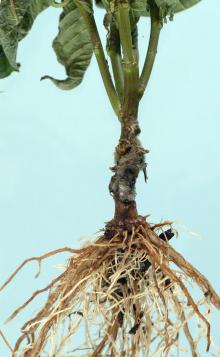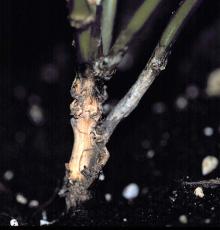See:
Greenhouse Plants, Ornamental - Gray Mold
Cause Botrytis cinerea, a fungus. The disease is especially severe on double cultivars and in cold, moist greenhouses. It can occur on all stages of development and on all plant parts. Conidia are easily dispersed by air currents. The fungus depends on a water film for conidial germination and infection. Nutrients on the surface of plants encourage infection. The fungus secretes cell-wall degrading enzymes ahead of the advancing infection. Older mature leaves are more susceptible to infection. Bracts or leaves damaged by several things, including bract burn (calcium deficiency), are easily colonized by this fungus. Wounded cuttings are also common sites of infection. Infected tissues that drop onto healthy plant parts are another way the fungus can spread. Latent infections are a common problem with disease development after plants are packed and shipped.
Symptoms Tan to brown lesions form on leaves, stems, and bracts. Long tan cankers can form on stems and induce wilting. Infected bracts of red poinsettias may turn purple. Lesions are often noticed first on the edges of young leaves and bracts, turning darker as they expand. Lesions grow into large necrotic wedges and may look zonate with repeated expansion. Latex may exude from the undersides of lesions. Affected parts become covered with a mass of gray spores.
Cultural control The focus is on keeping leaves and bracts dry. Maintaining temperatures above the dew point is very effective. Mature plants are very susceptible and management strategies should be intensified during crop finishing and postharvest handling. Wounds on both stock plants and cuttings during propagation are another critical stage for management.
- Space plants to allow good air circulation and get light to lower leaves. Wire mesh benches can help facilitate air movement.
- Grow with adequate nitrogen and light levels to prevent leaf senescence. Calcium is also an essential nutrient.
- Maintain night temperature above 60°F.
- Provide good air movement at night.
- Maintain a steady, relatively dry environment by keeping greenhouse humidity below 90%, increasing spacing between plants for good air circulation, and taking care not to splash water on foliage during watering. Heating the greenhouse at night (especially for zero or negative DIF) or venting around sunset may be necessary. Heating in the morning before sunup can also help prevent dew formation as air temperature increases faster than the temperature of plant parts. If using DROP or DIP for size control, do not let humidity rise above 90%.
- Remove dead plant debris and place in covered containers.
- Water such that plants are not wet for extended periods of time.
- The use of calcium chloride on stock plants prior to taking cuttings has been helpful.
Chemical control Use foliar sprays with cultural controls. Many fungicides do not allow use after bract development. An application prior to canopy closure will be helpful for management of stem rot. Tank-mix and/or alternate products with different modes of action to prevent the buildup of resistant fungi. Limit the use of any one group during crop production. Resistance to different chemical groups is common in both field and greenhouse grown crops.
- Astun at 10 to 17 fl oz/100 gal water. Group 7 fungicide. 12-hr reentry.
- Broadform at 4 to 8 fl oz/100 gal water. Group 7 + 11 fungicide. 12-hr reentry.
- Chipco 26019 FLO at 1 to 2.5 quarts/100 gal water. Group 2 fungicide. 12-hr reentry.
- Daconil Weather Stik at 1.38 pints/100 gal water. Do not use when bracts are forming. Group M5 fungicide. 12-hr reentry.
- Decree 50 WDG at 0.75 to 1.5 lb/100 gal water. Test on plants, especially bracts, before wide scale use. Group 17 fungicide. 12-hr reentry.
- KleenGrow at 6 to 38 fl oz/100 gal water. 48-hr reentry.
- Mancozeb-based products can be used as mixing partners and provide some protection. Group M3 fungicides. 24-hr reentry.
- Fore 80 WP at 1.5 lb/100 gal water plus a spreader-sticker.
- Protect DF at 1 to 2 lb/100 gal water plus 2 to 4 oz spreader-sticker.
- Orkestra at 4 to 6 fl oz/100 gal water. Group 7 + 11 fungicide. 12-hr reentry.
- Pageant at 6 to 12 oz/100 gal water. Do not use for Botrytis if used for powdery mildew and vice versa. Do not use with organosilicone-based adjuvants. Group 7 + 11 fungicide. 12-hr reentry.
- Palladium at 4 to 6 oz/100 gal water. Avoid excessive runoff to small plants, which may result in stunting and/or chlorosis. Use of a nonionic surfactant may help reduce spray residue on bracts. Group 9 + 12 fungicide. 12-hr reentry.
- Phyton 27 at 1.5 to 2 oz/10 gal water. Group M1 fungicide. 48-hr reentry.
- Spectro 90 WDG at 1 to 2 lb/100 gal water. Group 1 + M5 fungicide. 12-hr reentry.
- Spirato GHN at 1 to 2 fl oz/100 gal water. Use with oils or adjuvants may cause plant damage. Group 12 fungicide. 12-hr reentry.
- Terraguard SC at 4 to 8 fl oz/100 gal water. Group 3 fungicide. 12-hr reentry.
Biological control
- LALStop G46 WG (Clonostachys rosea [formerly Gliocladium catenulatum] strain J1446) at 0.13 oz/1 gal water. Do not use with other products in the tank. 4-hr reentry. O
Reference Pritchard, P.M., Hausbeck, M.K., and Heins, R.D. 1996. The influence of diurnal temperatures on the postharvest susceptibility of poinsettia to Botrytis cinerea. Plant Disease 80:1011-1014.




